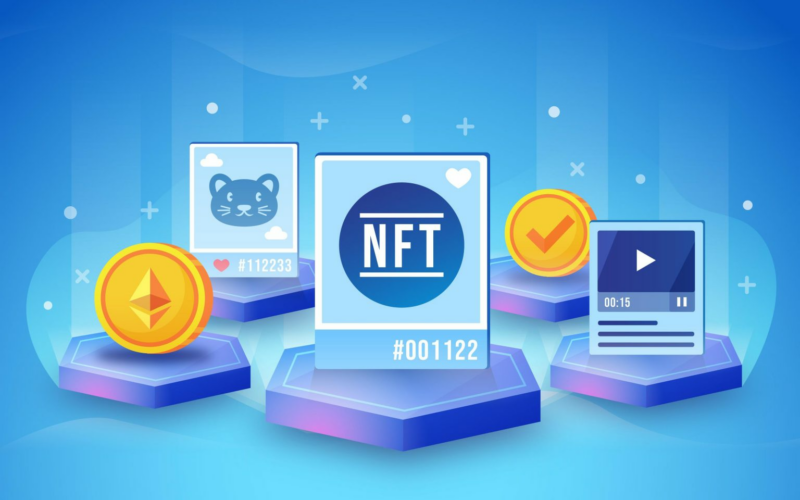Troy Warren for Mintified.Com #NFT
What are NFTs and how do they work?
NFTs are Non-Fungible Tokens. ‘Non-Fungible’ means that the tokens are unique and cannot be interchanged with one another. In practice, NFTs could represent many different types of assets – you can’t exchange an NFT artwork for an NFT video and still have the same thing. Even if you buy an NFT collectible trading card that is 1 of 10 released, each of the 10 cards will have a unique token id that makes them distinct from each other. In contrast, currency is fungible. It doesn’t really make a difference which $1 note you have because all of them are of the same value and serve the same purpose.
Aside from their uniqueness, much of the promise of NFTs stem from the technology itself. NFTs are stored on the blockchain as smart contracts, which are sets of self-executing code. It checks for certain conditions, and executes certain actions when those conditions are met. For example, every time a transaction is made, the smart contract can automatically allocate a percentage of the sale to the NFT’s creator as royalties. Because they live on the blockchain, NFTs also inherit the advantages provided by the blockchain itself. NFTs are immutable, highly traceable, and can be designed to be interoperable.
Digital art is the most common use case of NFTs today because the properties of NFTs make them a perfect way to represent unique pieces of art. This is probably the context in which most people have heard of NFTs, but the use cases of NFTs extend far beyond the creative. This article will walk you through some promising use cases of NFTs, and explore the transformational potential they can have for some industries.
Digital Art

The digital art market has long been plagued by authenticity issues because of how easy it is to find and copy art found online. NFTs solve this problem by making it quick and easy for anyone to check the authenticity and ownership of an artwork, as all this information is publicly available on the blockchain.
NFTs are also poised to democratize the art market by helping artists sell directly to consumers, and secure resale royalties. They allow peer-to-peer exchanges thus cutting out intermediaries that take cuts of profits, and circumvent traditional distribution models that may not be inclusive enough.
Because royalties are built directly into the smart contract, artists are guaranteed royalties from each resale. NFTs therefore put more power back into the hands of creators by giving them greater control over their works, removing barriers to market access, and providing opportunities for greater financial gains.
Collectibles

Beyond digital artworks, the same properties of NFTs make them very suitable for representing collectibles. Collectibles could be anything from trading cards, to digital avatars, game items, sports memorabilia and much more. As with artworks, getting a collectible authenticated can be a costly and time-consuming process. The value of collectibles also diminish if they are not in mint condition.
Because NFTs make it easy to prove the authenticity and rarity of digital items, NFTs allow for the creation of digital collectibles – something that was not really possible before because of how easy it is to copy digital files. With NFTs, you can now prove that the digital trading card you have is an original piece, and not a fake copy. Digital NFT Collectibles also cannot be damaged the same way a physical item can be, and therefore will not decline in value.
Still, NFT creators could offer both physical and digital versions of an item, for those of us who still buy books despite owning a kindle – because sometimes, it’s just nicer to feel the paper in your hands.
Gaming Items

Provable scarcity also makes NFTs great for representing game assets – because knowing that the rare sword they’re about to buy is one of only three in the entire ecosystem makes people more willing to fork out a fortune for it. Beyond that however, NFTs also add tremendous utility and value to game assets because they allow interoperability.
Traditional game items exist within proprietary systems that don’t usually communicate with one another. Buying an asset in one game means that it can only be used within that game environment. Game items that are represented by NFTs, however, can be made interoperable between different game environments as they’re all based on the same backend framework. Games based on the same blockchain network could allow users to transfer assets from one game to another, thus increasing the utility and value of in-game assets.
Memberships, Licenses and Certification

Because NFTs are unique, immutable, and live forever on the blockchain, they are a great alternative to printed licenses and certificates. NFTs can be publicly displayed through a crypto wallet, which will ease the burdens of physical storage and manual verification.
NFTs are also a great way to ensure that any certificates and licenses are authentic and haven’t been forged or tampered with. In fact, the country of San Marino is already using NFTs as COVID-19 vaccine passports, because it provides a much easier way to track and verify vaccination status.
NFTs can also be used as a membership token because of their uniqueness and immutability. Wallets can be connected to members’ accounts and used to log in to systems or prove memberships/subscriptions. It provides an easy way to keep track of members and distribute rewards by sending bonus tokens directly to members’ wallets.
Forget the heap of certificates, physical cards and phone applications you use now, and just imagine if all of these things were stored securely and digitally in just one place – your crypto wallet. Life would be a lot easier for everyone without unnecessary bureaucracy.
Real Estate

The speed, efficiency and accuracy of using smart contacts holds much promise for the real estate industry. Transactions in real estate are usually time-consuming and labour-intensive because of the sheer amount of verification and paperwork that needs to be processed with each sale.
Because smart contracts are self-executing code, they can process transactions much faster, and avoid potential errors that may be caused by manually processing paperwork. Furthermore, smart contracts circumvent intermediaries and their associated fees, leading to greater cost-efficiency.
Tokenizing properties also increases the liquidity of real estate and facilitates fractional ownership of assets, which will open up real estate investment to a wider base of investors. While this application of NFTs is still not fully developed, an apartment in Ukraine belonging to TechCrunch founder Michael Arrington has already been sold as an NFT.
How Will NFTs Change The World?
Aside from the use cases outlined in this article, there are many more potential applications for NFTs. The NFT market is still in its infancy, but it has shown tremendous transformational potential not just for the creator economy but also for governments and enterprises. As accessibility to the technology improves, everyone will begin to see the real utility of NFTs, and the positive, transformative effect it can have on the world.


































